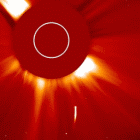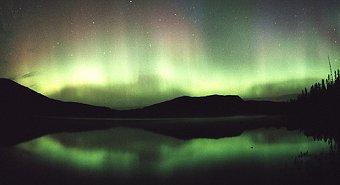What's Up in Space -- 28 May 2003
Subscribe to Space Weather News!
SOLAR BLAST: Magnetic fields near sunspot 365 erupted on May 27th and 28th, sparking a series of X-class solar flares and hurling at least one coronal mass ejection (CME) toward Earth. Geomagnetic activity could intensify on May 29th or 30th when the cloud sweeps past our planet. Sunspot 365 remains a threat for Earth-directed explosions in the days ahead.
Would you like to find out about solar flares the instant they happen? Sign up for SpaceWeather PHONE.
 KAMIKAZE COMETS: A pair of comets swung perilously close to the sun on May 24th; neither survived intact. In this SOHO coronagraph movie of the encounter, the ghostly tail of one comet continues past the sun after its icy nucleus was likely destroyed by the sun's intense heat. A smaller trailing comet vanishes entirely.
KAMIKAZE COMETS: A pair of comets swung perilously close to the sun on May 24th; neither survived intact. In this SOHO coronagraph movie of the encounter, the ghostly tail of one comet continues past the sun after its icy nucleus was likely destroyed by the sun's intense heat. A smaller trailing comet vanishes entirely.
These disintegrating comets were themselves fragments of a single enormous comet that broke apart thousands of years ago. Astronomers call them "Kreutz sungrazers" after the 19th-century astronomer Heinrich Kreutz who studied them in some detail. In recent years SOHO has spotted hundreds of Kreutz sungrazers streaming toward the sun. Most of them end up as these two did: vaporized. [more]
AURORA OUTLOOK: Earth is feeling the effects of a solar wind stream flowing from a coronal hole on the sun. Sky watchers should be alert for possible auroras tonight. The best viewing sites will be at high latitudes: e.g., southern parts of New Zealand and Australia, northern Europe, Canada and northern US states like Wisconsin and Michigan.

Above: On May 28th, photographer Dominic Cantin spotted these auroras over the Laurentides wildlife reserve north of Québec city.
Geomagnetic activity could intensify further on May 29th or 30th when CMEs en route to Earth arrive.
BIG SUNSPOT: Sunspot 365, which spans an area wider than six Earth-diameters, has been an active source of M-class and now X-class solar flares since it first appeared on May 24th. You can see sunspot 365 yourself, but never stare directly at the sun. Use safe solar projection techniques instead.

A 4-day animation of fast-growing sunspot 365. Credit: SOHO
LUNAR ECLIPSE: On May 15th, sky watchers from North America to Europe saw the normally-bright full moon disappear inside Earth's shadow--the first lunar eclipse of 2003. Visit our lunar eclipse gallery and see hundreds of photos from around the world.

